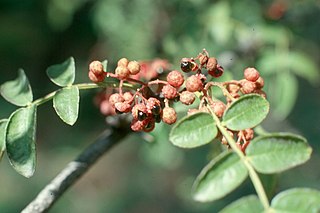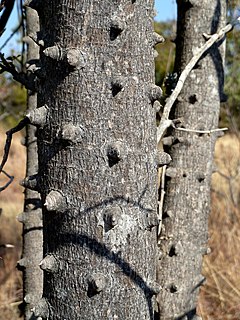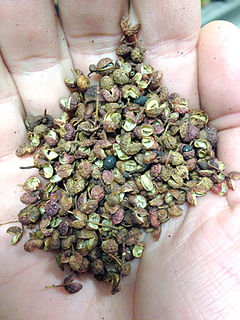
The Rutaceae is a family, commonly known as the rue or citrus family, of flowering plants, usually placed in the order Sapindales.

Zanthoxylum is a genus of about 250 species of deciduous and evergreen trees, shrubs and climbers in the family Rutaceae that are native to warm temperate and subtropical areas worldwide. It is the type genus of the tribe Zanthoxyleae in the subfamily Rutoideae. Several of the species have yellow heartwood, to which their generic name alludes.
Thomas Gordon Hartley was an American botanist.
Zanthoxylum ekmanii is a species of plant in the family Rutaceae. It is found in Belize, Costa Rica, Guatemala, Honduras, Mexico, Nicaragua, and Panama.
Zanthoxylum mollissimum is a species of plant in the family Rutaceae. It is found in Belize, Costa Rica, El Salvador, Guatemala, Honduras, Nicaragua, and Panama.
Zanthoxylum spinosum subsp. hartii is a species of plant in the family Rutaceae. It is endemic to Jamaica.

Zanthoxylum hawaiiense, commonly known aʻe or Hawaiʻi pricklyash, is a species of flowering plant in the family Rutaceae, that is endemic to Hawaii. It can be found at elevations of 550–1,740 m (1,800–5,710 ft) in dry forests, where it grows on lava flows, and mixed mesic forests on the Island of Hawaiʻi, Maui, Molokaʻi, and Lānaʻi. It is threatened by habitat loss.
Zanthoxylum heterophyllum is a species of plant in the family Rutaceae. It is found in Mauritius and Réunion. It is threatened by habitat loss. Formerly this species also occurred in Rodrigues, where it had been eradicated. In Mauritius less than 40 individuals are known in the wild.
Zanthoxylum juniperinum is a species of plant in the family Rutaceae. It is found in Belize, Costa Rica, Guatemala, Honduras, Mexico, Nicaragua, and Panama.
Zanthoxylum psammophilum is a species of shrub or small tree in the family Rutaceae. It is a large liana endemic to Côte d'Ivoire, although in 2005 it was found in Liberia as well. Zanthoxylum psammophilum, a new combination created in 1975 to subsume the genus Fagara into the genus Zanthoxylum based on morphology and secondary metabolites, is the preferred name according to the Conservatoire et Jardin botaniques de la Ville de Genève which has a section that specializes in the conservation and biodiversity of flowering plants of Côte d'Ivoire. The type specimen for the plant was collected in the ecotone between the lowland Eastern Guinean forests and the inland Guinean forest-savanna mosaic in the Lagunes District.

Zanthoxylum punctatum, also known as the St. Thomas prickly-ash, is a species of plant in the family Rutaceae. It is found in Puerto Rico, the British Virgin Islands, and the United States Virgin Islands. Its natural habitats are tropical and subtropical dry broadleaf forests and shrublands. It is threatened by habitat loss, and is the only on St. John listed as "endangered".

Zanthoxylum fagara or wild lime, is a species of flowering plant that—despite its name—is not part of the genus Citrus with real limes and other fruit, but is a close cousin in the larger citrus family, Rutaceae. It is native to southern Florida and Texas in the United States, and to Mexico, Central America, the Caribbean, and South America as far south as Paraguay. Common names include: lime prickly-ash, wild lime, colima, uña de gato, and corriosa.

Zanthoxylum brachyacanthum, known as thorny yellowwood, satinwood, satinwood or scrub mulga, is a species of flowering plant in the family Rutaceae and is endemic to north-eastern Australia. It is a rainforest shrub or tree with thick, cone-shaped spines on the trunk and prickles on the branches, pinnate leaves, and male and female flowers arranged in panicles.

Zanthoxylum americanum, the common prickly-ash, common pricklyash, common prickly ash or northern prickly-ash, is an aromatic shrub or small tree native to central and eastern portions of the United States and Canada. It is the northernmost New World species in the citrus family, Rutaceae, and is the type species in its genus, which includes sichuan pepper. It can grow to 10 meters (33 ft) tall with a diameter at breast height (DBH) of 15 cm (5.9 in). It produces membranous leaflets and axillary flower clusters. The wood is not commercially valuable, but oil extracts from the bark have been used in traditional and alternative medicine, and have been studied for antifungal and cytotoxic properties. The genus name is sometimes spelled Xanthoxylum.
Zanthoxylum dipetalum is a rare species of tree in the family Rutaceae and in the same genus as Szechuan pepper. It is known by the Hawaiian names Kāwa'u and Heaʻe and is endemic to the Hawaiian archipelago, where it grows in forests on 3 or 4 of the islands.

Zanthoxylum capense, the small knobwood, is a species of plant in the family Rutaceae. It occurs in the eastern regions of southern Africa, from the vicinity of Knysna, Western Cape to the Zimbabwean granite shield and coastal Mozambique. It tolerates a range of altitudes, from highveld to coastal elevations, but is most prevalent in dry thickets or on rocky slopes and outcrops.

Zanthoxylum schinifolium, also called mastic-leaf prickly ash, is a species of flowering plant in the Rutaceae, the citrus family, which, along with Z. simulans and Z. bungeanum is known as Sichuan pepper and used as a spice.

Sichuan pepper is a spice commonly used in the Sichuan cuisine of China's southwestern Sichuan Province. When eaten it produces a tingling, numbing effect due to the presence of hydroxy-alpha sanshool in the peppercorn. It is commonly used in Sichuan dishes such as mapo doufu and Chongqing hot pot, and is often added together with chili peppers to create a flavor known as málà.

Zanthoxylum rhetsa, commonly known as Indian prickly ash, is a species of flowering plant in the family Rutaceae and occurs from India east to the Philippines and south to northern Australia. It is a deciduous shrub or tree with cone-shaped spines on the stems, pinnate leaves with between nine and twenty-three leaflets, panicles of white or yellowish, male and female flowers, followed by spherical red, brown or black follicles.












